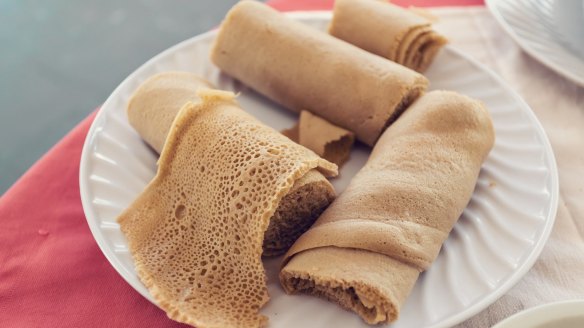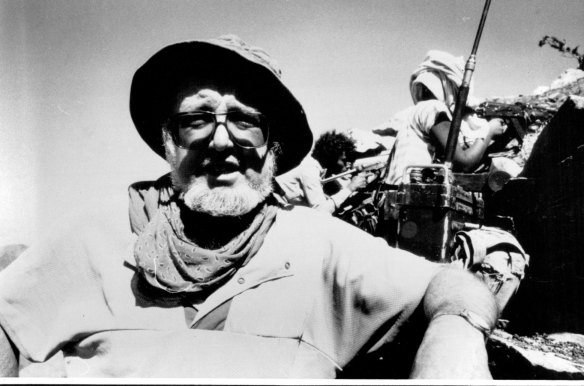Thomas Keneally on the joy of feasting after famine

Thomas Keneally has written 30 novels, dramas, screenplays and books of non-fiction. He won the Booker Prize in 1982 for Schindler's Ark, which was made into Schindler's List (1993) by Steven Spielberg and went on to win seven Academy Awards. He has won Australia's most prestigious literary prize, the Miles Franklin, twice: for Bring Larks and Heroes (1967) and Three Cheers for the Paraclete (1968). We were delighted when he agreed to write this story for Two Good.
I am not boasting when I say I'm not a gastronomic tourist. I am more a gawper at cathedrals and old town squares and historic associations. Menus are a side issue in my travels.
It is true that when I first went to China in the aftermath of the Cultural Revolution I was bowled over by the range of food available from Shanghai to Xian to Chengdu, and the banquets and liquors to which our small party were treated. I realised that our local Chinese restaurant [in Australia] served just one rich strand of Chinese cooking, Cantonese, often, in the old days, with added MSG. But the food was not the point of my travels there.
Meals blur in memory. I have been fed superbly well for a long lifetime, often by women, occasionally – more primitively – by myself. Most humans have had to live with dried and salted food. Whereas I was born mid-Depression in the era of the icebox and Coolgardie safe, and grew up in the age of the refrigerator, with the unprecedented options it offered. I bless those options as I bless all of the preparing hands. But of all the meals I have eaten, one I remember best is a meal I could barely confront.
A little more than 30 years back I was persuaded by a fine Eritrean man and now Australian citizen, Fessahaie Abraham, and by the forceful Fred Hollows, to visit Eritrea in the Horn of East Africa myself. It was then, in the global view, a province of Ethiopia, but it was fighting valiantly, and in a full-scale frontal and guerrilla war, against first the Emperor of Ethiopia and then, at the stage I first went, the Stalinist ruler Mengistu. I organised to write about the war for The New York Times colour magazine, about the aftermath of the famine (the one we in the West call the Bob Geldof famine), and the society of rebel Eritrea and how it functioned under the complete air-dominance of Mengistu's Russian-equipped airforce.
Even getting there was a test. You went through the Sudan but could not let the Sudanese officials know that you were headed south-east, via an empty quarter of the utterly arid Sudanese coast, into the highlands of Eritrea. Once there, you could travel only by night because of the bombers. I reached Orotta, the hospital dug into mountainsides where Fred Hollows famously operated during his visits to Eritrea.
Raised by a mother who insisted on good manners, I did my very best to fake enthusiasm for the coming goat beano.
I met my guide, a prematurely grizzled veteran. I adopted him like a brother. For I could not call out of the country, there was no fax (at that stage perhaps the most popular form of communication), and I could not be sure when I would get out to the Sudan again – it depended on room being available on an outgoing truck. And from the time I saw my first wounded soldier at dusk that day, a 19-year-old infantrywoman shot in the pelvis, I was out of my depth.
We travelled all over the country, my guide and I, through the highlands, visiting armies, schools, food distributions, the front line, encountering nomads, speaking to highland Christians and, down on the coast and over towards the Sudanese border, lowland Muslims. Even the teenage shepherds had AK-47s. It was a nation at war, and insofar as any war is just, this was a palpably valid one against a tyrannous overlord.
The flatbread which was the basis of all our meals was called injera, and was made of a fermented grain named teff, a species of lovegrass native to the Horn. It is bitter to the taste but much more flavoursome than wheat. An unfamiliar grain can make a person sick at first acquaintance – there were tales of malnourished East Africans being fed emergency wheat and falling into a fatal diarrhoea and nausea.

I became sick from eating from plates of injera and lentils, injera and spaghetti, injera and chickpeas. Eritrea had been an Italian colony until World War II and had good pasta. Any injera left over at the end of a meal was sun-dried on a rock and then crushed and brewed into an opaque beer.
I became sick on injera. Unlike a true antipodean tough guy like Fred Hollows, I was a tender reed. It got to the stage where my guide had to near carry me. One night in the lowlands, after I got sick from helping push a truck out of a bog, he rested me in a malaria clinic, a camouflaged stone structure full of shrouded fever sufferers.
Another day, since day was the rest period in that nation turned upside-down by bombing, it was in a bunker that had, at the head of the sleeping platform, a box of captured Russian grenades. I was sick enough to tell myself that I didn't care if they all went off at once.
Yet again, I was assigned a thatched hut in whose roof there lived a little tribe of barking geckos, who jumped about sociably above me and seemed to discuss what a wuss I was. And all the time my guide talked about how, when we got back to Orotta, a goat would be killed, and we could binge on goat meat. Raised by a mother who insisted on good manners, I did my very best to fake enthusiasm for the coming goat beano.
One night and at last, we rolled into the dugout garage by the stone guesthouse of Orotta. When we got up the following morning, a slaughtered goat hung over a killing pit on the rise above us. Guests had been invited: an Eritrean surgeon from the hospital in the valley below, some friends of the guide, a few public servants who ran life in this community hidden from the sky. And for the feast, as prelude for myself and any other booze-deprived diner, a bottle of Asmara gin, captured from some Ethiopian supply dump, was available.
In the forenoon our fellow diners assembled, and they were all male except for a young woman officer and her new husband. This young woman and her husband were freshly married, the night before. It is the impulse of humans to initiate a marriage with a high-protein feast, and goat was as high protein as you could get in the Eritrean highlands.
They were a splendid couple, those two, and graced the feast. Their joy and love was brittle – they were both soldiers of the Eritrean People's Liberation Front, and had both been fighting since their teens. The young woman, burping softly on the beer made from fermented injera, possessed a broad-faced frank beauty, but there was still four years of struggle left to impinge on her and her husband.
With a little help from the very good Italian-style Asmara gin, I began to see that I, a male who had always lived in the protein heaven of a lucky nation, was very rightly the mere pretext for this feast that the others at this table so notably needed and had earned. As they bit into the rich knuckles of goat meat I began to relish the joy they took, and at one stage the bright-eyed young fighter looked across at me, her eyes alive with geniality, her mouth full of meat, and smiled.
Where is she now? God forbid she's dead, like so many of her sisters, or a victim of the post-revolutionary mayhem of Eritrea. Has she risked drowning trying to escape from Africa, like so many Eritreans escaping the land they bled for and which they were forced to flee? I hope she is running an injera-style Eritrean and Ethiopian restaurant in Oslo or Hamburg or Houston, and boasting to customers about her kids' PhDs. I hope she and her husband are as alive as they were that day when, struggling to down injera and goat meat, I learned to find joy in the consumption and delight of others.
As a man of 83 years who has had my oesophagus cut out because of cancer, I take frank pleasure pressing particular entrees or desserts on grandchildren and friends, and seeing their eyes change under the impact of culinary joy. It is a trick I became conscious of in Eritrea, at the great goat and injera blow-out of 1987.
This is an edited extract from The Two Good Cookbook, $40, which will be published on November 1.